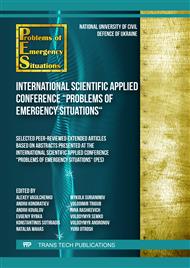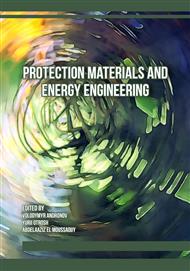[1]
IEC 60050-461:2008. International Electrotechnical Vocabulary (IEV) – Part 461: Electric cables, Geneva, 2008, URL: https://webstore.iec.ch/publication/212.
Google Scholar
[2]
Statystyka pozhezh // Instytut derzhavnoho upravlinnia ta naukovykh doslidzhen z tsyvilnoho zakhystu. URL: http://undicz.dsns.gov.ua [in Ukrainian].
Google Scholar
[3]
Popov O., Iatsyshyn A., Kovach V., Artemchuk V., Taraduda D., Sobyna V., Sokolov D., Dement M., Hurkovskyi V., Nikolaiev K., Yatsyshyn T., Dimitriieva D. Physical features of pollutants spread in the air during the emergency at NPPs. Nuclear and Radiation Safety, 4 (84) (2019), 11.
DOI: 10.32918/nrs.2019.4(84).11
Google Scholar
[4]
O. Popov, A. Iatsyshyn, V. Kovach, V. Artemchuk, D. Taraduda, V. Sobyna, D. Sokolov, M. Dement and T. Yatsyshyn, Conceptual approaches for development of informational and analytical expert system for assessing the NPP impact on the environment, Nuclear and Radiation Safety, (2018).
DOI: 10.32918/nrs.2018.3(79).09
Google Scholar
[5]
O. Popov, D. Taraduda, V. Sobyna, D. Sokolov, M. Dement and A. Pomaza-Ponomarenko, Emergencies at Potentially Dangerous Objects Causing Atmosphere Pollution: Peculiarities of Chemically Hazardous Substances Migration. Studies in Systems, Decision and Control, 298 (2020) 151–163.
DOI: 10.1007/978-3-030-48583-2_10
Google Scholar
[6]
O. Nuianzin, S. Pozdieiev, V. Hora, A. Shvydenko and T. Samchenko, Experimental study of temperature mode of a fire in a cable tunnel, Eastern-European Journal of Enterprise Technologies, 3 (10–93) (2018) 21–27.
DOI: 10.15587/1729-4061.2018.131792
Google Scholar
[7]
O. Popov, A. Iatsyshyn, V. Kovach, V. Artemchuk, D. Taraduda, V. Sobyna, D. Sokolov, M. Dement, V. Hurkovskyi, K. Nikolaiev, T. Yatsyshyn and D. Dimitriieva, Physical features of pollutants spread in the air during the emergency at NPPs, Nuclear and Radiation Safety, 4 (84) (2019) 11.
DOI: 10.32918/nrs.2019.4(84).11
Google Scholar
[8]
R.V. Zaitsev, M.V. Kirichenko, K.A. Minakova, G.S. Khrypunov, A.N. Drozdov, I.V. Khrypunova and D.S. Prokopenko, DC–DC Converter for High-Voltage Power Take-Off System of Solar Station, 2nd Ukraine Conference on Electrical and Computer Engineering (UKRCON-2019), Conference proceedings, (2019) 582-587.
DOI: 10.1109/ukrcon.2019.8879860
Google Scholar
[9]
K.A. Minakova, R.V. Zaitsev, Biaxial Heat Balance Model of Solar Collector, Journal of nano- and electronic physics, 14 (4) (2022) 04030-1 – 04030-4.
DOI: 10.21272/jnep.14(4).04030
Google Scholar
[10]
A.V. Kondratiev, V.E. Gaidachuk, Mathematical analysis of technological parameters for producing superfine prepregs by flattening carbon fibers, Mechanics of Composite Materials, 57, 1 (2021) 91–100.
DOI: 10.1007/s11029-021-09936-3
Google Scholar
[11]
B. Pospelov, E. Rybka, M. Samoilov, I. Morozov, Y. Bezuhla, T. Butenko, Y. Mykhailovska, O. Bondarenko and J. Veretennikova, Defining the features of amplitude and phase spectra of dangerous factors of gas medium during the ignition of materials in the premises, Eastern-European Journal of Enterprise Technologies, 2 (10 (116)) (2022) 57–65.
DOI: 10.15587/1729-4061.2022.254500
Google Scholar
[12]
I.K. Domnich, R.I. Kravchenko, O.V. Kulakov, I.O. Solodovnikov and I.O. Kharchenko, Pozhezhna bezpeka kabelnoi produktsii: Praktychnyi posibnyk, UСZU, Kharkiv, 2008 [in Ukrainian].
Google Scholar
[13]
O. Vambol, A. Kondratiev, S. Purhina and М. Shevtsova, Determining the parameters for a 3D-printing process using the fused deposition modeling in order to manufacture an article with the required structural parameters, Eastern-European Journal of Enterprise Technologies, 2/1 (110) (2021) 70–80.
DOI: 10.15587/1729-4061.2021.227075
Google Scholar
[14]
О. Kulakov, А. Katunin, Y. Kozhushko, S. Herasymov, I. Vasil'eva and O. Konovalenko, Definition of accumulated operating time distributions for a cable product insulation within the defined life cycles, 2019 IEEE 2nd Ukraine Conference on Electrical and Computer Engineering (UKRCON 2019), (2019) 355-358.
DOI: 10.1109/ukrcon.2019.8879803
Google Scholar
[15]
Ł. Kantor, K. Michalik and J. Laska, Engineering polymers with high mechanical and thermal resistance for electric motors, Sci, Tech. Innov., 1 (2017) 38-42.
DOI: 10.5604/01.3001.0010.7553
Google Scholar
[16]
M.I. Baranov and S.V. Rudakov, Electrothermal Action of the Pulse of the Current of a Short Artificial-Lightning Stroke on Test Specimens of Wires and Cables of Electric Power Objects, Journal of Engineering Physics and Thermophysics, 91 (2) (2018) 544-555.
DOI: 10.1007/s10891-018-1775-2
Google Scholar
[17]
K. Lindqvist, M. Andersson, A. Boss et al, Thermal and Mechanical Properties of Blends Containing PP and Recycled XLPE Cable Waste, J Polym Environ, 27 (2019) 386–394.
DOI: 10.1007/s10924-018-1357-6
Google Scholar
[18]
H. Chen, V.V. Ginzburg, J. Yang, Y. Yang, W. Liu, Y. Huang, L. Du and B. Chen, Thermal conductivity of polymer-based composites: Fundamentals and applications, Progress in Polymer Science, 59 (2016) 41-85.
DOI: 10.1016/j.progpolymsci.2016.03.001
Google Scholar
[19]
A.R.J. Hussain, A.A. Alahyari, S.A. Eastman, C. Thibaud-Erkey, S. Johnston and M.J. Sobkowicz, Review of polymers for heat exchanger applications: Factors concerning thermal conductivity, Applied Thermal Engineering, 113 (2017) 1118-1127.
DOI: 10.1016/j.applthermaleng.2016.11.041
Google Scholar
[20]
C. White, K.M. White and J. Pickett, Service Life Prediction of Polymers and Plastics Exposed to Outdoor Weathering, (2017) 342.
DOI: 10.1016/b978-0-323-49776-3.00001-5
Google Scholar
[21]
Y. Otrosh, A. Kovalov, O. Semkiv, I. Rudeshko and V. Diven, Methodology remaining lifetime determination of the building structures, MATEC Web of Conferences, 230 (2018) 02023.
DOI: 10.1051/matecconf/201823002023
Google Scholar
[22]
A. Kovalov, Yu. Otrosh, M. Surianinov and T. Kovalevska, Experimental and computer researches of ferroconcrete floor slabs at high-temperature influences, Materials Science Forum, 968 (2019) 361–367.
DOI: 10.4028/www.scientific.net/msf.968.361
Google Scholar
[23]
B. Pospelov, E. Rybka, R. Meleshchenko, S. Gornostal and S. Shcherbak, Results of experimental research into correlations between hazardous factors of ignition of materials in premises, Eastern-European Journal of Enterprise Technologies, 6 (10–90) (2017) 50–56.
DOI: 10.15587/1729-4061.2017.117789
Google Scholar
[24]
B. Pospelov, V. Andronov, E. Rybka, V. Popov and O. Semkiv, Development of the method of frequency-temporal representation of fluctuations of gaseous medium parameters at fire, Eastern-European Journal of Enterprise Technologies, 2/10 (92) (2018) 44–49.
DOI: 10.15587/1729-4061.2018.125926
Google Scholar
[25]
Yu. Otrosh, O. Semkiv, E. Rybka and A. Kovalov, About need of calculations for the steel framework building in temperature influences conditions, IOP Conference Series: Materials Science and Engineering, 708 (1) (2019) 012065.
DOI: 10.1088/1757-899x/708/1/012065
Google Scholar
[26]
A. Vasilchenko, Yu. Otrosh, N. Adamenko, E. Doronin and A. Kovalov, Feature of fire resistance calculation of steel structures with intumescent coating, MATEC Web of Conferences, 230 (2018) 02036.
DOI: 10.1051/matecconf/201823002036
Google Scholar
[27]
A. Kovalov, Y. Otrosh, S. Vedula, O. Danilin and T. Kovalevska, Parameters of fire-retardant coatings of steel constructions under the influence of climatic factors, Naukovyi Visnyk Natsionalnoho Hirnychoho Universytetu, 3 (2019) 46–53.
DOI: 10.29202/nvngu/2019-3/9
Google Scholar
[28]
V. Sadkovyi, V. Andronov, O. Semkiv, A. Kovalov, E. Rybka, Yu. Otrosh et. al, Fire resistance of reinforced concrete and steel structures, Kharkiv, 2021, 180.
DOI: 10.15587/978-617-7319-43-5
Google Scholar
[29]
S. Pozdieiev, O. Nuianzin, S. Sidnei and S. Shchipets, Computational study of bearing walls fire resistance tests efficiency using different combustion furnaces configurations, MATEC Web of Conferences, 116 (2017) 02027.
DOI: 10.1051/matecconf/201711602027
Google Scholar
[30]
B. Pospelov, V. Andronov, E. Rybka, M. Samoilov, O. Krainiukov, I. Biryukov, T. Butenko, Y. Bezuhla, K. Karpets and E. Kochanov, Development of The Method of Operational Forecasting of Fire in the Premises of Objects Under Real Conditions, Eastern-European Journal of Enterprise Technologies, 2 (2021) 43-50.
DOI: 10.15587/1729-4061.2021.226692
Google Scholar
[31]
B. Pospelov, V. Andronov, E. Rybka, R. Meleshchenko and P. Borodych, Studying the recurrent diagrams of carbon monoxide concentration at early ignitions in premises, Eastern-European Journal of Enterprise, 3/9 (93) (2018) 34–40.
DOI: 10.15587/1729-4061.2018.133127
Google Scholar
[32]
B. Pospelov, V. Andronov, E. Rybka, R. Meleshchenko and S. Gornostal, Analysis of correlation dimensionality of the state of a gas medium at early ignition of materials, Eastern-European Journal of Enterprise Technologies, 5/10 (95) (2018) 25–30.
DOI: 10.15587/1729-4061.2018.142995
Google Scholar
[33]
B. Pospelov, E. Rybka, O. Krainiukov, O. Yashchenko, Y. Bezuhla, S. Bielai, E. Kochanov, S. Hryshko, E. Poltavski and O. Nepsha, Short-term forecast of fire in the premises based on modification of the Brown's zero-order model, Eastern-European Journal of Enterprise Technologies, 4/10 (112) (2021) 52–58.
DOI: 10.15587/1729-4061.2021.238555
Google Scholar
[34]
V. Andronov, B. Pospelov and E. Rybka, Development of a method to improve the performance speed of maximal fire detectors, Eastern-European Journal of Enterprise Technologies, 2 (9–86) (2017) 32–37.
DOI: 10.15587/1729-4061.2017.96694
Google Scholar
[35]
V. Andronov, B. Pospelov, E. Rybka and S. Skliarov, Examining the learning fire detectors under real conditions of application, Eastern-European Journal of Enterprise Technologies, 3 (9–87) (2017) 53–59.
DOI: 10.15587/1729-4061.2017.101985
Google Scholar
[36]
B. Pospelov, V. Andronov, E. Rybka and S. Skliarov, Research into dynamics of setting the threshold and a probability of ignition detection by selfadjusting fire detectors, Eastern-European Journal of Enterprise Technologies, 5 (9-89) (2017) 43–48.
DOI: 10.15587/1729-4061.2017.110092
Google Scholar
[37]
B. Pospelov, V. Andronov, E. Rybka and S. Skliarov, Design of fire detectors capable of self-adjusting by ignition, Eastern-European Journal of Enterprise Technologies, 4 (9–88) (2017) 53–59.
DOI: 10.15587/1729-4061.2017.108448
Google Scholar
[38]
V. Andronov, B. Pospelov and E. Rybka, Increase of accuracy of definition of temperature by sensors of fire alarms in real conditions of fire on objects, Eastern-European Journal of Enterprise Technologies, 4 (5–82) (2016) 38–44.
DOI: 10.15587/1729-4061.2016.75063
Google Scholar
[39]
Jouleov zakon, URL: https://wikideck.com/bs/Jouleov_zakon.
Google Scholar
[40]
Heat transfer, URL: https://en.wikipedia.org/wiki/Heat_transfer.
Google Scholar
[41]
A. Kondratiev, V. Pistek, L. Smovziuk, M. Shevtsova, A. Fomina, P. Kucera, A. Prokop, Effects of the temperature-time regime of curing of composite patch on repair process efficiency. Polym., 13(24) (2021) 4342.
DOI: 10.3390/polym13244342
Google Scholar
[42]
Pravyla ulashtuvannia elektroustanovok, Kyiv, 2017 [in Ukrainian].
Google Scholar
[43]
IEC 60287-1-3:2002. Electric cables – Calculation of the current rating – Part 1-3: Current rating equations (100 % load factor) and calculation of losses – Current sharing between parallel single-core cables and calculation of circulating current losses, Geneva, 2002, URL: https://webstore.iec.ch/publication/1268.
DOI: 10.3403/02908170u
Google Scholar



